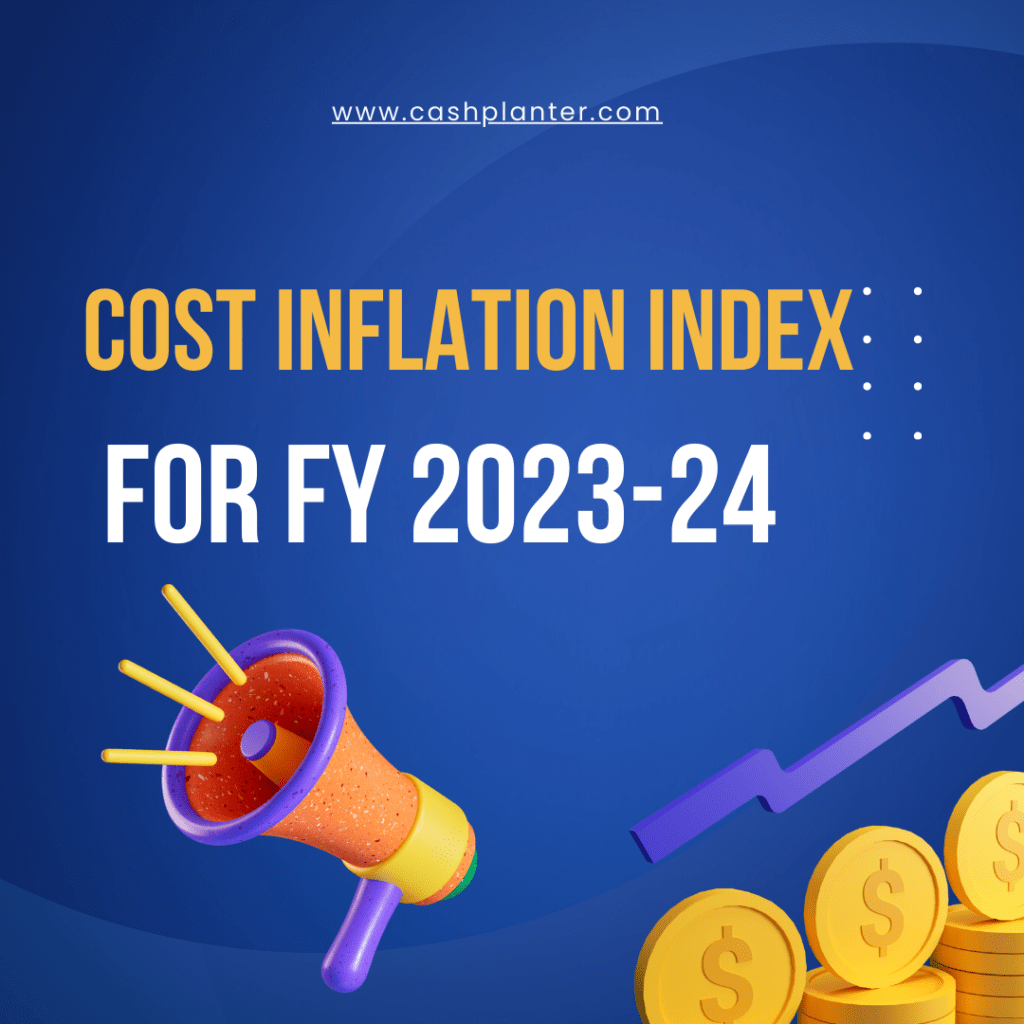
Cost Inflation Index: Unleashing the Power of Tax Efficiency FY2023-2024
Introduction
When it comes to income tax, understanding the concept of Cost Inflation Index (CII) is crucial. The Cost Inflation Index is a financial tool used by taxpayers in India to calculate the adjusted cost of an asset for the purpose of determining capital gains. This article delves into the specifics of the Cost Inflation Index and its importance in the computation of income tax.
Understanding Cost Inflation Index (CII)
The Cost Inflation Index is a measure of inflation published by the Indian government every year. The purpose of CII is used to adjust the purchase price of an asset, taking into account the effect of inflation over time. This adjustment helps in determining the real gain or loss on the sale of an asset by adjusting the cost price to the current value.
Calculation of Capital Gains
To calculate capital gains, the indexed cost of acquisition is subtracted from the sale price of the asset. The indexed cost of an asset is derived by multiplying the original cost of acquisition with the ratio of the CII of the year of sale to the CII of the year of acquisition. This indexed cost ensures that the impact of inflation is appropriately accounted for while calculating capital gains.
Importance of Cost Inflation Index in Income Tax
The Cost Inflation Index is vital for income tax purposes as it helps in determining the accurate capital gains on the sale of assets. By adjusting the cost of acquisition with the CII, taxpayers can ensure that they pay taxes only on the real gain and not on the impact of inflation. This index helps in providing a fair and accurate calculation of capital gains, avoiding any undue tax burden.
Historical CII Values
The Indian government releases the CII values every financial year. These values are essential for calculating capital gains accurately. It is crucial to refer to the relevant CII values for the respective financial years to ensure precise calculations. Taxpayers can access historical CII values through official government sources or professional tax advisory services.
Benefits of Cost Inflation Index
The Cost Inflation Index offers several benefits to taxpayers. Some of the key advantages include:
- Accurate Capital Gains Calculation: The CII ensures that the impact of inflation is considered, resulting in accurate capital gains calculations.
- Reduced Tax Liability: By adjusting the cost of acquisition using the CII, taxpayers can potentially reduce their tax liability by accounting for the impact of inflation.
- Fair Assessment: The CII provides a fair and equitable method of assessing capital gains, considering the purchasing power of the currency over time.
Factors Affecting Cost Inflation Index
The Cost Inflation Index is influenced by various factors. Some of the key factors that affect the CII are:
- Inflation Rate: The rate of inflation prevailing in the economy plays a significant role in determining the CII values.
- Economic Conditions: Economic conditions, such as changes in the GDP growth rate and price levels, can impact the CII.
- Government Policies: Government policies related to inflation and taxation also influence the CII values.
Impact of CII on Long-Term Capital Assets
The Cost Inflation Index has a substantial impact on long-term capital assets. The Capital Assets held for the long term, such as real estate or stocks, are subject to significant price fluctuations due to inflation. The CII helps in adjusting the purchase price of these assets, ensuring that the tax liability reflects the actual gain or loss over the holding period.
Applicability of CII for Different Asset Types
The Cost Inflation Index is applicable to various types of assets, including but not limited to:
- Real Estate: Residential or commercial properties, land, and buildings.
- Stocks and Mutual Funds: Equity shares, preference shares, ETFs and units of mutual funds.
- Bonds and Debentures: Government bonds, corporate bonds, and debentures.
- Gold and Precious Metals: Physical gold, silver, platinum, etc.
Also Read The Power of Investing Early
How to Use Cost Inflation Index for Calculating Capital Gains
To calculate capital gains using the Cost Inflation Index, follow these steps:
- Determine the year of acquisition and sale of the asset.
- Obtain the relevant CII values for the respective financial years.
- Calculate the indexed cost of acquisition by multiplying the original cost with the ratio of CII values.
- Subtract the indexed cost from the sale price to determine the capital gains.
- Report the capital gains accurately in the income tax return.
Let’s consider an example to illustrate the calculation of capital gains using the Cost Inflation Index (CII).
Suppose Mr. Sharma purchased a residential property on April 1, 2010, for Rs. 50 lakhs. He sold the property on September 1, 2022, for Rs. 1 crore. We will calculate the indexed cost of acquisition and the capital gains using the latest Cost Inflation Index values.
According to the latest CII table published by Income Tax Department of India (2022-2023), the CII value for the financial year 2010-2011 is 167, and for the financial year 2022-2023 is 331, then the cost inflation index is 331/167=1.982. Here’s how the calculation of capital gain would be done:
1. Calculate the indexed cost of acquisition of capital asset: Indexed Cost = (Cost of Acquisition of capital asset) x (CII of the Year of Sale) / (CII of the Year of Acquisition of capital asset) Indexed Cost = (50,00,000) x (400) / (167) Indexed Cost = Rs. 99,10,180
2. Calculate the capital gains: Capital Gains = (Sale Price) – (Indexed Cost of Acquisition) Capital Gains = (1,00,00,000) – (99,10180) Capital Gains = Rs. 89,820 (as there is a gain in this case)
3. Using the indexation method incurs a tax liability of 20 percent. The calculated tax liability amounts to Rs. 17,964, which is 20% of 89820.
4. If the indexation method is not utilized, a tax of 10% is applicable to the capital gain. In this scenario, the capital gain of asset is determined by subtracting the cost of acquisition from the sale price of the property, resulting in Rs.50,00,000 (1,00,00,000 – 50,00,000). Consequently, the capital gains tax amounts to Rs.5,00,000 (10% X 50,00,000).
In this example, Mr. Sharma incurs a capital gain of Rs. 89,820 using indexation and a capital gain of Rs 50,00,000 without indexation. So Mr. Sharma opted the indexation method to calculate the capital gain of assets.
By employing the indexation method, one can effectively reduce their tax liability. This method allows for the adjustment of the purchasing price of the apartment based on current market prices. As a result, it enables individuals to save on taxes while ensuring a fair assessment of their capital gains.
Please note that the Cost Inflation Index values are subject to change each financial year. It is important to refer to the latest CII table provided by the Indian government for accurate calculations.

Cost Inflation Index
According to Notification 44/2024, dated 24-05-2024, the following table must be utilized for the “Cost Inflation Index:”
| Sl. No. | Financial Year | Cost Inflation Index |
| 1 | 2 | 3 |
| 1 | 2001-02 | 100 |
| 2 | 2002-03 | 105 |
| 3 | 2003-04 | 109 |
| 4 | 2004-05 | 113 |
| 5 | 2005-06 | 117 |
| 6 | 2006-07 | 122 |
| 7 | 2007-08 | 129 |
| 8 | 2008-09 | 137 |
| 9 | 2009-10 | 148 |
| 10 | 2010-11 | 167 |
| 11 | 2011-12 | 184 |
| 12 | 2012-13 | 200 |
| 13 | 2013-14 | 220 |
| 14 | 2014-15 | 240 |
| 15 | 2015-16 | 254 |
| 16 | 2016-17 | 264 |
| 17 | 2017-18 | 272 |
| 18 | 2018-19 | 280 |
| 19 | 2019-20 | 289 |
| 20 | 2020-21 | 301 |
| 21 | 2021-22 | 317 |
| 22 | 2022-23 | 331 |
| 23 | 2023-24 | 348 |
| 24 | 2024-24 | 363 |
Frequently Asked Questions -Cost Inflation Index (FAQs)
- What is the Cost Inflation Index (CII)? The Cost Inflation Index is a financial tool used to adjust the purchase price of an asset for the impact of inflation over time.
- Why is the Cost Inflation Index important in income tax calculations? The Cost Inflation Index is crucial in income tax calculations as it helps in determining the accurate capital gains on the sale of assets, considering the impact of inflation.
- Where can I find the historical Cost Inflation Index values? Historical Cost Inflation Index values can be obtained from official government sources or professional tax advisory services.
- Does the Cost Inflation Index apply to all types of assets? Yes, the Cost Inflation Index is applicable to various types of assets, including real estate, stocks, bonds, and gold.
- How can I use the Cost Inflation Index for calculating capital gains? To calculate capital gains using the Cost Inflation Index, multiply the original cost of acquisition with the ratio of CII values to obtain the indexed cost, and subtract it from the sale price.
Conclusion
The Cost Inflation Index is an essential tool in income tax calculations, providing a fair and accurate method of calculating capital gains. By considering the impact of inflation, taxpayers can ensure precise calculations and avoid any undue tax burden. Understanding the concept and application of the Cost Inflation Index is crucial for individuals and businesses involved in capital asset transactions.
it is advisable to consult with licensed professional tax advisors or refer to official government sources to stay updated on the latest tax regulations and make informed financial decisions.



